Personalizing with visitor groups
One way you can personalize a digital experience in Optimizely is to create a visitor group Site visitors with something in common, such as age, geographic location, and so on. Used in the personalization feature of Optimizely CMS. (See Personalizing Content.) with criteria for that group. For example, you can design a product banner specifically for first-time visitors Someone who visits a website using a web browser. In most cases, a visitor can use public functions and services but cannot create content and has limited access to community content. In an SEO context, visitor means the number of visits to a URL through channels (external referrers), direct arrivals, and internal links. (See also visitor groups.), or for visitors from a geographic region or market. For information about visitor group criteria, see Administering visitor groups.
In Optimizely CMS, you can personalize any type of content in the rich-text editor and in a content area; personalize part of a text, an image, or a block in the CMS rich-text editor, or personalize an image, a block or a page in a content area, if you have these in your web pages.
If you have multiple visitor groups, a visitor may match more than one visitor group. You then can use personalization groups to group content to avoid displaying the same content twice, and display fallback content to visitors who match no visitor groups.
The preview option in the top menu lets you preview the personalized content as the visitor groups will see it, before publishing.
Applying personalization
In the rich-text editor
- In Optimizely CMS, open the page for editing, and select the content you want to personalize in the editor area.
- Click Personalized Content
 in the editor toolbar.
in the editor toolbar. - Select one or more visitor groups from the list.
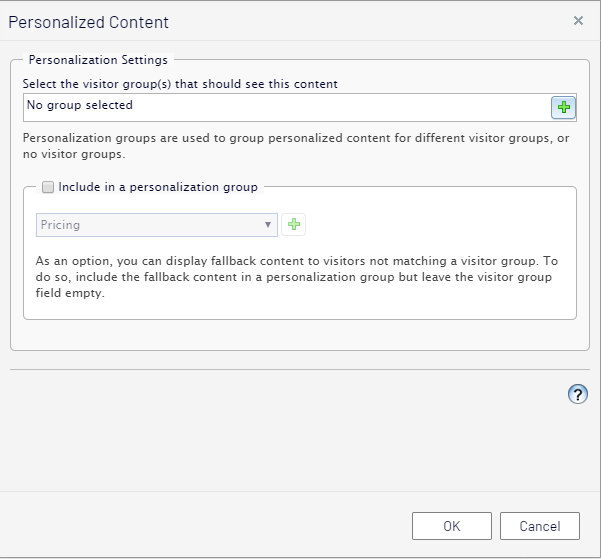
- Preview the personalized content to verify the result. To do this, click
 >
>  .
.
In the content area
- Open the page for editing, and select the content you want to personalize in the content area.
- Select Personalize from the context menu.
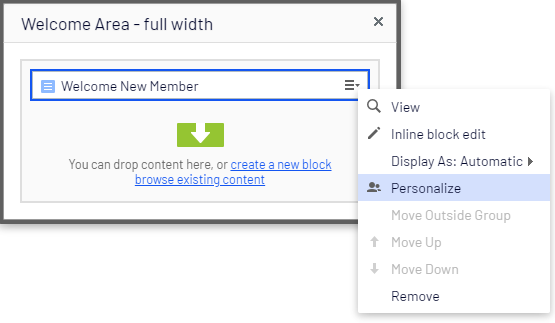
- Select one or more visitor groups from the list.
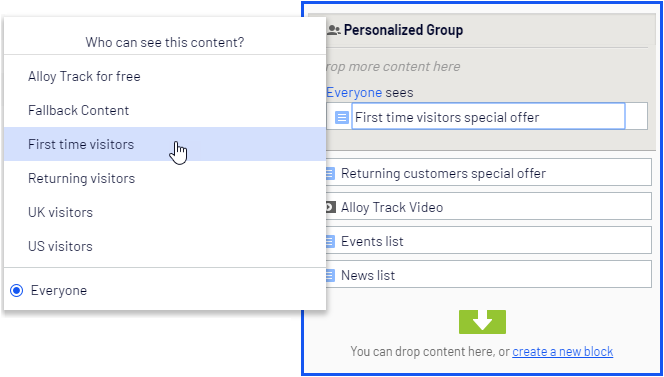
- Preview the personalized content to verify the result. To do this, click
 >
>  .
.
Editing and removing personalization settings
In the rich-text editor
Click edit for the personalized content, and update the personalization settings, or select Remove Personalization.
In the content area
Expand the desired Personalized Group section and click the desired visitor group link to edit the settings. To exclude content from personalization Adapt content to customized target groups for a more personalized website experience, such as displaying different content to first time and returning visitors. (See visitor groups.), drag it outside the group, or select Move Outside Group in the context menu.
In the rich-text editor

The non-personalized text at the top of the rich-text editor in this example is always displayed. The personalized text appears only to visitors matching any of the visitor groups UK visitors and US visitors.
In the content area
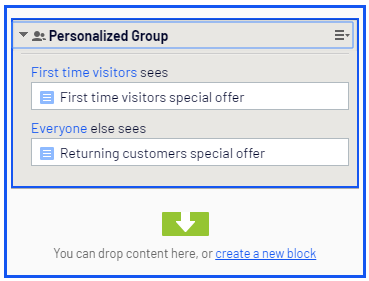
In this example, Returning visitors see one block, and First time visitors see another. Visitors that do not match any group do not see anything in this content area.
You want to display specific price information to visitors from the UK and US, and other price information to visitors from other countries. To avoid displaying price information twice for visitors from the UK and US, you need to use a personalization group for fallback content.
The order in which the personalized content is placed within a personalization group does not matter, but placing the fallback content at the end makes it easier to follow the personalization flow.
In the rich-text editor
Select the fallback the default action if no criteria is met; without a fallback, no action occurs. price information text and personalize it without selecting a visitor group. Instead create a Pricing personalization group and apply this.
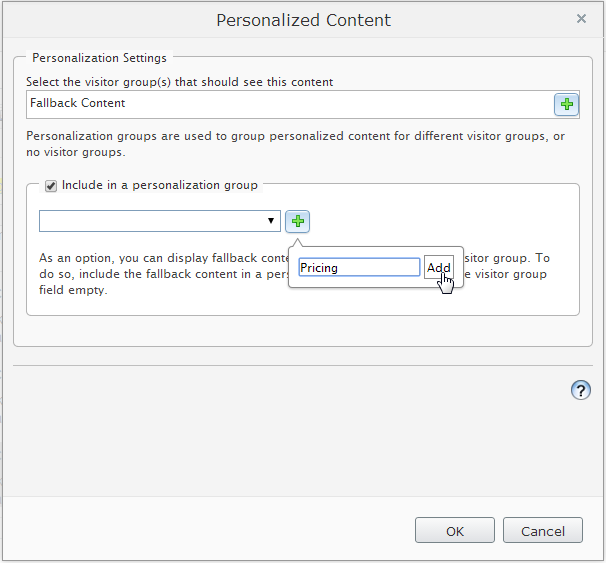
Personalize the price information texts for the UK and US visitor groups, and also include them in the "Pricing" personalization group. The personalization group appears to the right.
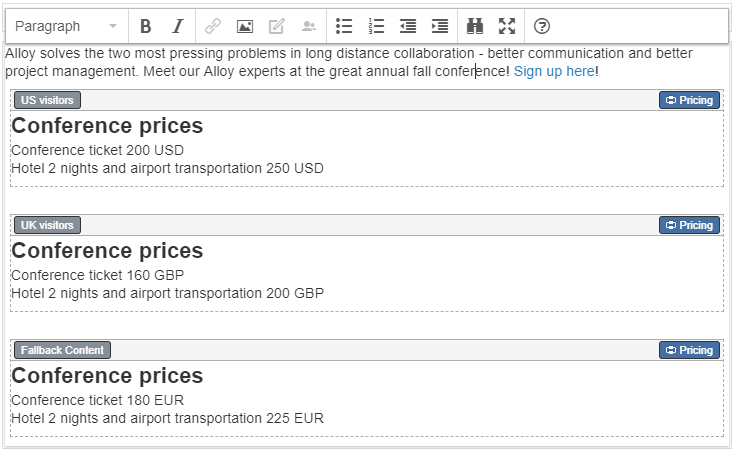
Now the personalization for this content is matched within the same personalization group.
In the content area
This example shows pricing information as individual blocks, and the Default pricing is the fallback content displayed to visitors from other countries than the UK and US. Select Personalization in the context menu for a block to create a personalization group, and drag the other blocks into the group.
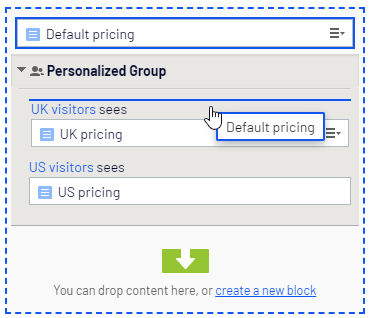
Personalize each block within the group by applying the appropriate visitor group. Use the Everyone option to display the fallback content displayed to visitors not matching any visitor group.
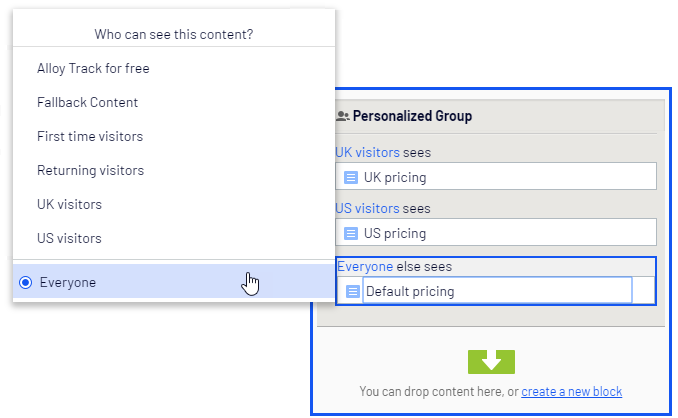
Search engine indexation and visitor groups
Search engines crawl your website to index your content. So what if your content is personalized through visitor groups, what will the search engine crawler see? It all depends on how the visitor group is assessed at the point of crawl. If you have a visitor group Visitors from the UK , the crawler will index the content personalized for UK if the crawler has an IP that is identified as being in the United Kingdom. Otherwise that content is not indexed.
Another example is where a date/time visitor group criteria has been applied. If you have a Weekend only visitor group, then the content will be indexed if the crawler comes along at the weekend, otherwise not.
It is good practice to have Everyone content in a group, if it is important that something is shown (or crawled) in a area of the page.
Providing access to content using visitor groups
Administrators can also grant access to specific content using visitor groups. For example, the administrator can make a page or a block accessible only to visitors from the UK, by providing access for the UK visitors visitor group; see Access rights.
 Personalizing Commerce content with visitor groups
Personalizing Commerce content with visitor groups
If you have Optimizely Commerce installed, there are additional visitor group criteria available specific for e-commerce scenarios. See Commerce-specific criteria.
 Personalizing with connector add-ons and visitor groups
Personalizing with connector add-ons and visitor groups
You can also personalize content through marketing automation connectors, if you have Marketo installed on your website, for example. See examples in the following video tutorials.